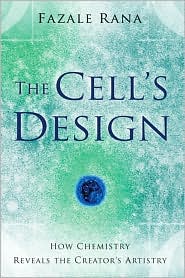 Arguments for intelligent design often hinge upon what mechanistic, naturalistic means “cannot explain.” The arguments go something like “See feature x, how can naturalistic mechanisms explain x? They cannot. Therefore, ID is true.” There is something to be said for this type of argument. If one simply cannot explain a specific thing by means of the mechanisms suggested, one must look for different means. That said, if the case for intelligent design rested only upon negative arguments, it would not be as robust as if it also had positive evidence.
Arguments for intelligent design often hinge upon what mechanistic, naturalistic means “cannot explain.” The arguments go something like “See feature x, how can naturalistic mechanisms explain x? They cannot. Therefore, ID is true.” There is something to be said for this type of argument. If one simply cannot explain a specific thing by means of the mechanisms suggested, one must look for different means. That said, if the case for intelligent design rested only upon negative arguments, it would not be as robust as if it also had positive evidence.
Fazale Rana’s book, The Cell’s Design, seeks to present just such positive evidence. The sheer volume of fine-tuning required to make a cell work baffles the imagination and, Rana argues, serves as positive evidence for design.
Rana’s argument is an argument from analogy. He draws heavily from William Paley’s “watchmaker” example (If one came across a watch in the sand, they’d know it was designed… Paley argued that one could similarly conclude that life was designed). Rana doesn’t ignore the arguments raised against such analogical reasoning, but confronts them head on. After identifying several criteria which allow proper analogical reasoning (30ff), Rana makes his case for the Creator.
The first line of evidence comes from the machines in the cell. Again, Rana’s approach is analogical, rather than negative. The machine-like nature of the flagellum, along with other motor-like cellular functions presents an argument: “Organisms display design. Therefore, organisms are the product of a creator” (86).
The case doesn’t rest merely upon molecular machines. Rather, that is but one of the many lines of evidence. Rana draws out the implications of several “chicken-and-egg” paradoxes. These include the “mutual interdependence of DNA and proteins” (99), the origin of proteins themselves (100ff), and more (105ff). These systems present a kind of “irreducible complexity in which the system depends on the system to exist” (108).
Other elements of design are present in the cell as well. Aquaporins intricate and detailed workings illustrate the design that is present in the system (111ff). Other detailed, intricate designs (such as collagen, mRNA, and the breakdown of proteins) hint at the need for a designer. But the reasoning is not only supported by the details, it is also bolstered by the structural composition of the cell (126ff). The analogy of cells to machines is strengthened further by the quality control systems within the cell (198ff). Again, the reasoning is analogical–these things are designed, therefore they need a designer.
“Information can’t be separated from the activity of an intelligent agent” (142). The numerous examples of information in the cell lead to the inference of an agent. But it is not only the information’s presence that hints at a designer. Here Rana’s case really builds on and develops the work of other ID theorists. The information alone could be enough to infer an agent, but one must also account for the fact that cellular information follows rules like syntax, semantics, and pragmatics (144ff). It is not merely information, it is the use of that information and the rules governing that use that strengthen the case for an agent behind the information.
One of the most amazing parts of The Cell’s Design is the chapter called “A Style All His Own.” Darwinian evolution, if rewound, would come out different ways every time. Different mutations would occur, which would lead to different organisms. What is not expected, on Darwinism, is a convergence pattern in evolution. When the same templates keep showing up through independent routes of development, it provides strong evidence for a designer. Yet this “molecular convergence” is exactly what scientists have discovered again and again. On pages 207-214 Rana writes, with citations from scientific journals, of no less than 100 examples of molecular convergence. As a reader, one can’t help but be stunned as they go through these pages. Over and over, there is evidence that the same designs show up in different places, independently, throughout nature. As Rana writes, “if life emanates from a Creator, it’s reasonable to expect he would use the same designs repeatedly…” (215). And this repetition of design is found in life’s most basic components: DNA (216ff).
Rana does not ignore detractors arguments against his position. One counter-argument to Rana’s conclusions is the presence of poorly-designed mechanisms in nature. Yet Rana effectively nullifies these examples, citing how many of them have turned out to be optimally tuned for life, and how others may be expected to be equally tuned (258ff).
The Cell’s Design is an extremely difficult read, but it does not leave readers who are not scientists to flounder. Rana’s second and third chapters provide some basic biological understanding which readers must have to understand the argument throughout the rest of the book. There is also a 12-page glossary at the back of the book which will let those unfamiliar with the terminology follow along. That said, this is not an easy book. The argument is heavily scientific and involves an exploration, in extreme detail, of the mechanisms and machines at work in the cell. The book presents a fantastic case for ID, but not at the expense of the details.
Finally, it is important to underscore the reasoning behind Rana’s conclusions. His argument is abductive. He explicitly outlines it:
1) X is observed
2) If Y were true, then X would be expected.
3) There is good reason to believe that Y is true.
In the case of the cell:
1) Design is observed in biochemical systems.
2) If life stemmed from the direct work of a Creator, the elegant design of biochemical systems would be expected.
3) There is good reason to believe that life is the product of a Creator (276, these arguments are an exact quote).
After reading through The Cell’s Design, this reader cannot help but agree with this argument. Over and over again, Rana has drawn out the exquisite design in the cell. The positive evidence is there, life is designed.
The Cell’s Design presents a phenomenal case for a designer of life. Those interested in exploring intelligent design should add this book to their list. It is not an easy read, by any means, but it provides some explicit, positive evidence for the conclusion that a Creator exists. Those wishing to deny this fact will find much with which they must contend in Rana’s work. I recommend it without reservation.
Source:
Fazale Rana, The Cell’s Design (Grand Rapids, MI: Baker, 2008).
Disclaimer: I was provided with a review copy of this book by Reasons to Believe. You can learn more about this science-faith think tank at reasons.org.
SDG.
——
The preceding post is the property of J.W. Wartick (apart from citations, which are the property of their respective owners) and should not be reproduced in part or in whole without the expressed consent of the author. All content on this site is the property of J.W. Wartick and is made available for individual and personal usage. If you cite from these documents, whether for personal or professional purposes, please give appropriate citation with both the name of the author (J.W. Wartick) and a link to the original URL. This blog is protected by Creative Commons licensing. By viewing any part of this site, you are agreeing to this usage policy.

I have not read this book, though I am somewhat familiar with Rana. I have to say, though, that from your review, his case doesn’t seem all that “phenomenal” to me. In fact, I see very little that hasn’t been said many times before by ID theorists and answered just as many times by evolutionists. For example, the statement, “What is not expected, on Darwinism, is a convergence pattern in evolution,” is just false. Contemporary evolutionists have no trouble whatsoever with this; they even have a nickname for it: a “good trick.” Also, his basic argument strategy seems weak to me. It would only be a good argument if Y is the only or clearly the best explanation for X. But this is obviously not the case with the appearance of design in biochemical systems. There is at least one other contending explanation that is at least as strong (and nearly all experts in the relevant fields would say stronger). Thus, I don’t see that this argument provides “positive evidence” for the “direct work of a creator” (here I take it that what Rana means by this is Hugh Ross’ theory of progressive creationism). I would also like to hear more about how Rana responds to the objections to Paley-type analogical reasoning.
Posted by Robert Whitaker | October 29, 2011, 10:46 AMRana does respond to arguments against analogical reasoning. Hume’s argument, for example, is based upon disanalogy. But the more we’ve discovered about the cell, the closer the analogy to a machine seems, considering there are biochemical machines inside the cell itself.
You wrote, ” For example, the statement, ‘What is not expected, on Darwinism, is a convergence pattern in evolution,’ is just false. Contemporary evolutionists have no trouble whatsoever with this; they even have a nickname for it: a ‘good trick.'”
I am obviously no evolutionary biologist, so take this as you will. I think the name “good trick” implies that it is not expected. If the explanation is that “Well those ‘good tricks’ happen once in a while, after all, it’s random!” then I don’t think that shows such convergence would be predicted on that model. These things are expected if design were the case. I haven’t seen what the argument for them being a “good trick” is, so I can’t respond to it much more than that.
Rana acknowledges that any given component of the cell can be explained through a naturalistic story. I recall Edgar Andrews writing the same type of argument in “Who Made God?” Certainly, we can come up with any number of scenarios to explain how various cellular mechanisms arose. The problem is that there are dozens (hundreds?) of these mechanisms to explain, and the explanations would have to happen simultaneously, because the cell could not function without, for example, the membrane or a genetic code, or proteins. The argument is cumulative. Again, if Rana’s argument were based on irreducible complexity alone, or on whether evolution could bring about feature X, it would be much weaker. The difficulty is with variant (often mutually exclusive) means of generating various components of the cell all operating at once to bring it together.
Posted by J.W. Wartick | October 29, 2011, 10:59 AM